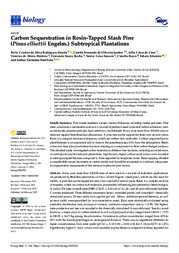Carbon Sequestration in Resin-Tapped Slash Pine (Pinus elliottii Engelm.) Subtropical Plantations.
Carbon Sequestration in Resin-Tapped Slash Pine (Pinus elliottii Engelm.) Subtropical Plantations.
Resumo: Every year more than 150,000 tons of resin used in a myriad of industrial applications are produced by Brazilian plantations of Pinus elliottii Engelm. (slash pine), which are also used for timber. A pine tree can be tapped for resin over a period of several years. Resin is a complex mixture of terpenes, which are carbon-rich molecules, presumably influencing pine plantation carbon budgets. A total of 270 trees (overall mean DBH of 22.93 ± 0.11 cm) of 14-, 24-, and 26-year-old stands had their C content measured. Three different treatments (intact, wounded panels, and wounded + chemically stimulated panels, 30 trees each) were applied per site. Above- and belowground biomass, as well as resin yield, were quantified for two consecutive years. Data were statistically evaluated using normality distribution tests, analyses of variance, and mean comparison tests (p ≤ 0.05). The highest resin production per tree was recorded in the chemically stimulated 14-year-old stand. Tree dry wood biomass, a major stock of carbon retained in cell wall polysaccharides, ranged from 245.69 ± 11.73 to 349.99 ± 16.73 kg among the plantations. Variations in carbon concentration ranged from 43% to 50% with the lowest percentages in underground biomass. There was no significant difference in lignin concentrations. Soils were acidic (pH 4.3 ± 0.10?5.83 ± 0.06) with low C (from 0.05% to 1.4%). Significantly higher C stock values were recorded in pine biomass compared to those reported for temperate zones. Resin-tapping biomass yielded considerable annual increments in C stocks and should be included as a relevant component in C sequestration assessments of planted pine forests.
Ano de publicação: 2023
Tipo de publicação: Artigo de periódico
Unidade: Embrapa Cerrados
Observações
1 - Por padrão são exibidas publicações dos últimos 20 anos. Para encontrar publicações mais antigas, configure o filtro ano de publicação, colocando o ano a partir do qual você deseja encontrar publicações. O filtro está na coluna da esquerda na busca acima.
2 - Para ler algumas publicações da Embrapa (apenas as que estão em formato ePub), é necessário ter, no celular ou computador, um desses softwares gratuitos. Sistemas Android: Google Play Livros; IOS: iBooks; Windows e Linux: software Calibre.
Acesse outras publicações
Acesse a Base de Dados da Pesquisa Agropecuária (BDPA) para consultar o acervo completo das bibliotecas da Embrapa.

